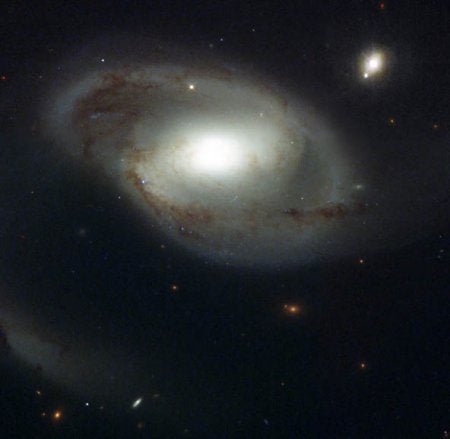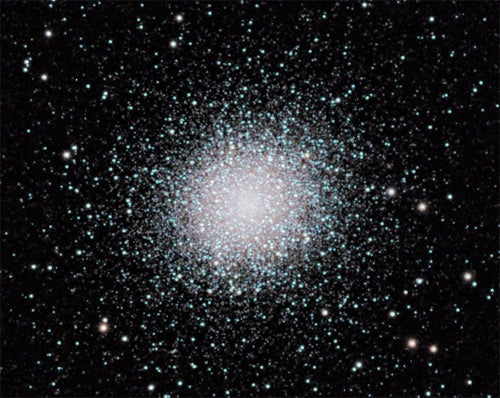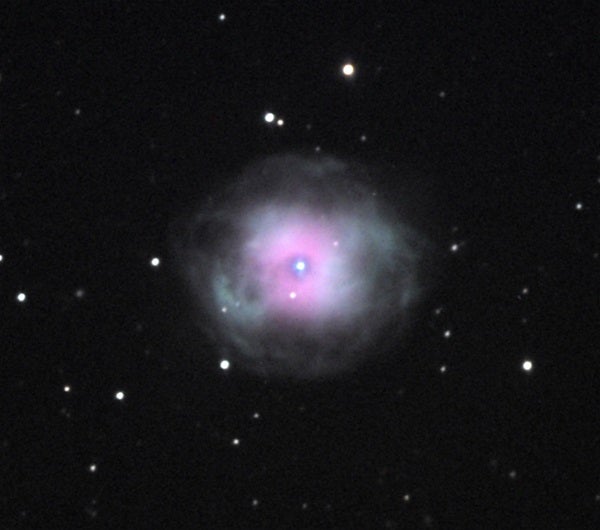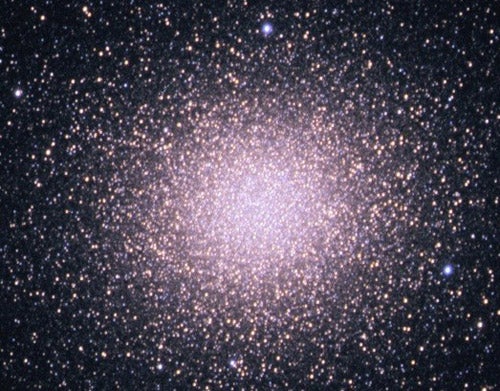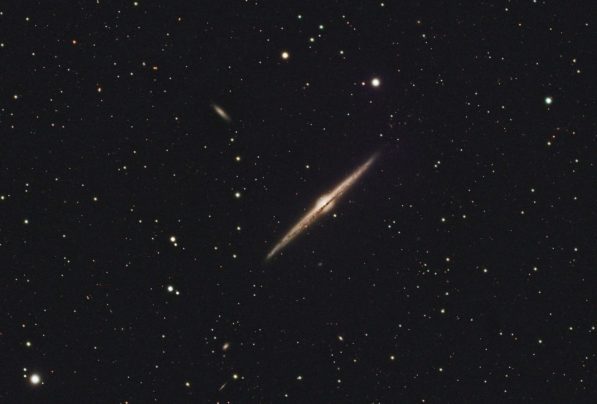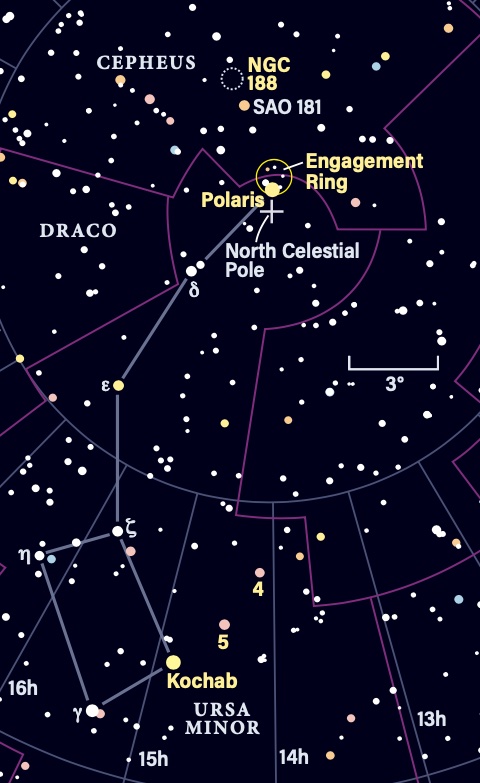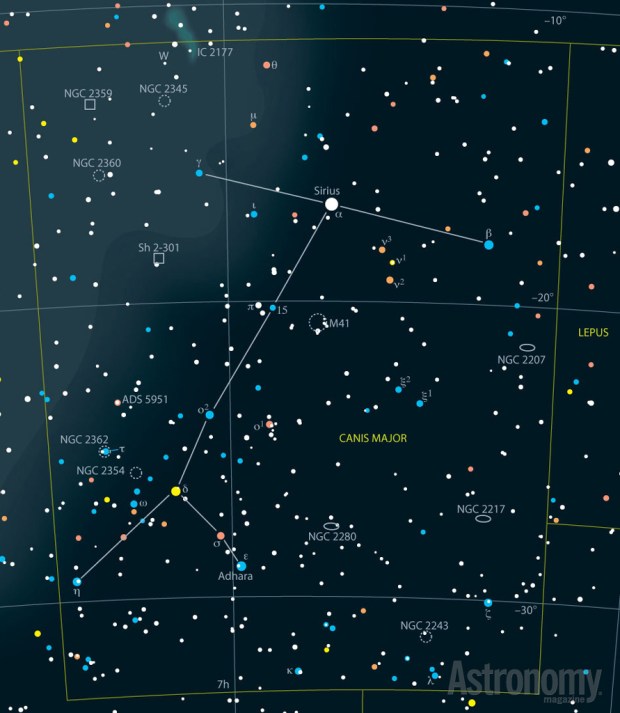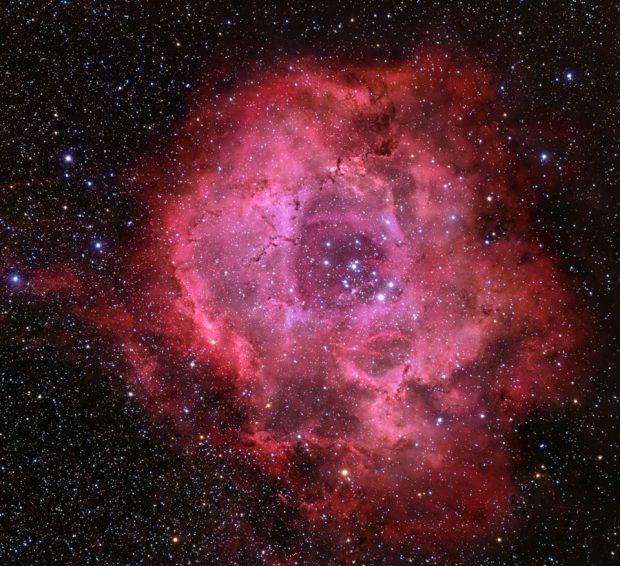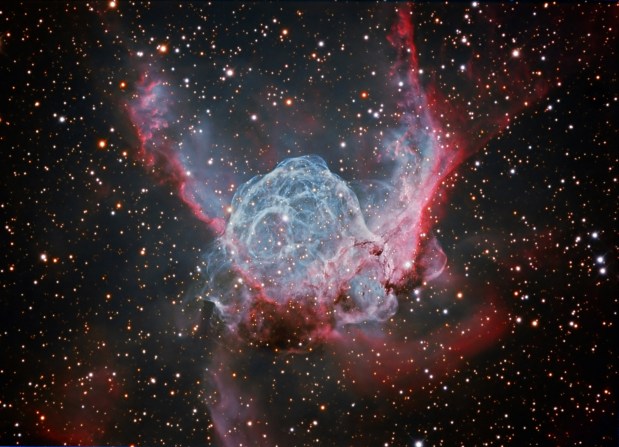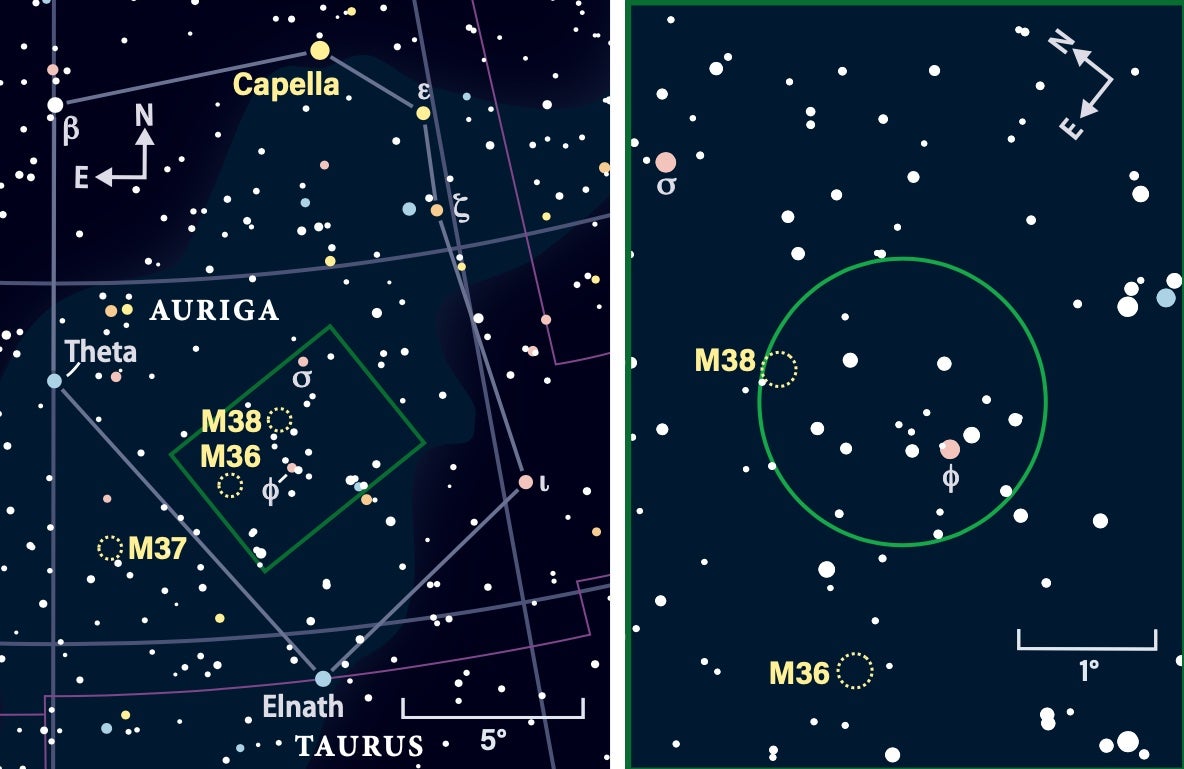One of the oddest pairs in the sky is also much celebrated. NGC 4319, a 13th-magnitude galaxy in Draco, is a nice little barred spiral that’s easy to see with a 12-inch or 14-inch scope. What makes this interesting is the 16th-magnitude quasar, Markarian 205, that lies a short distance from the galaxy’s center, to the upper right in this view made with the Hubble Space Telescope.
In the 1980s, American astronomer Halton Arp and several colleagues made this pair the subject of a debate. While redshifts indicated a distance of about 80 million light-years for the galaxy and a distance about 15 times greater for the quasar, Arp and friends contended they saw, in long exposures, a luminous bridge of material connecting the two objects. This would have cast doubt on redshift measurements as reliable distance indicators. But nearly all astronomers agree the bridge between the two objects was an artifact and that the objects are indeed widely separated in space.
Another great spring target is the NGC 3190 galaxy group in Leo, also known as Hickson Compact Group 44. This great collection of galaxies includes NGC 3190, at bottom center, an 11th-magnitude spiral with a warped disk and a nicely visible edge-on dust lane. To its upper right, near the bright star, is the 11th-magnitude elliptical galaxy NGC 3193. At upper right, the weird, twisted, bluish galaxy is NGC 3187, a 13th-magnitude barred spiral with oddly distorted arms.
A large backyard scope shows enticing detail in all of these galaxies, particularly on a very dark night and with slow, careful sweeping of the eyepiece at moderate or high powers. The group is typical of the many compact groups of galaxies in the universe and lies about 50 million light-years away, about the same distance as the Virgo cluster.
To enter a more extreme range of challenge, try a springtime galaxy cluster. One of the best is Abell 1656, the Coma cluster of galaxies. Large numbers of galaxies are members of big clusters with dozens to hundreds of galaxies bound up gravitationally together in a cloud. Such is the case with the Coma cluster, a group of dozens of galaxies some 400 million light-years distant. The two brightest members of the cluster, NGC 4889 and NGC 4874 — visible in this image as the fuzzy objects near center below the bright, overexposed star — are the dominant members of the group.
These two galaxies are monsters, each several times larger than normal spirals like the Milky Way. Classified as cD galaxies, these objects have grown over time by pulling smaller galaxies into their gravitational lock and eating them, absorbing the gas, dust, and stars, and making themselves bloat. Supermassive black holes inhabit these galaxies’ centers.
Although it may look just like a star, 3C 273 in Virgo is a neat object to find, as it is the prototypical quasar. In 1963, Caltech astronomer Maarten Schmidt discovered that this object had a huge redshift, making it extremely distant and, at 13th magnitude, extremely energetic. Over the years, astronomers have found that quasars are the extraordinarily powerful centers of young galaxies, whose energy output is so high because central black holes are swallowing vast amounts of matter, converting some of it to energy, and shooting some of it outward in the process.
At a distance of 2.4 billion light-years, 3C 273 is one of the closest quasars.
Of course, thousands of objects closer to home look really good in large scopes. One of the best springtime clusters in the sky is M13, the Hercules Cluster. This famous cluster in the “keystone” of Hercules is celebrated as the most popular globular in the Northern Hemisphere sky. Glowing at magnitude 5.9 and spanning half the width of the Full Moon, the Hercules Cluster lies 23,000 light-years away and holds as many as three-quarters of a million stars.
Armed with a large scope, you’ll have no problem resolving the outer edges of M13 into pinpoint stars and probably straight across most of the core, too. Look for several faint background galaxies within a field of view or two of the cluster’s perimeter. The brightest is NGC 6207, a 12th-magnitude spiral some 50 million light-years distant.
Some springtime objects look nearly photographic when viewed with large scopes. On a dark, crisp night, you’ll get a magnificent view of the Blackeye Galaxy, M64, in Coma Berenices. Named for the dark cloud that lies close to the galaxy’s central hub, the Blackeye is a typical spiral that’s close enough, at 24 million light-years, to be bright and detailed under a dark sky.
The Blackeye shines at magnitude 8.5 and has a diameter of more than 9 arcminutes, making even low-power views of it satisfying. Look for the galaxy’s bright, condensed center, of course the black eye itself, and bright concentric rings of light that appear to overlap each other moving away from the galaxy’s center. The whole thing is then enveloped in a faint cloud of nebulosity, the unresolved light from millions of faint stars.
One of the most attractive types of objects for large scopes are weird planetary nebulae, as they tend to be bright and show interesting details, even on less than perfect nights. Try NGC 4361 in Corvus as a great example. This bright object surrounds the 13th-magnitude dying star that puffed it away. Look for a glowing shell with a bright, inner, circular disk encased in an irregular, weirdly shaped outer ring.
Doug Neal imaged the planetary nebula from Martinez, Georgia.
For a contrast, try the strange planetary NGC 3242 in Hydra, the so-called Ghost of Jupiter. This object is much smaller and will stand higher magnifications, which will show you a blue-green disk surrounding a 12th-magnitude central star. Look for a brighter area within the nebula, an oblong case around the star, that glows more brightly than the circular disk that surrounds it.
To get a really weird object, though, one that shows phenomenal detail in a large scope, you’ll need a sky that reaches down into the Southern Hemisphere constellation Centaurus. The erratic galaxy Centaurus A, NGC 5128, is a nearby galaxy classed as a peculiar object. It’s probably the result of two galaxies that collided in the distant past and have fully merged, creating a galactic train wreck.
Even a small telescope shows the galaxy’s prominent central dust band, which warps as it wraps around the galaxy’s outer edges. Large scopes will show you a remarkable sight: giant clouds of star-formation regions, visible as the bright stuff set against the dust band itself. Imagine seeing bursts of new stars being created at a distance of some 14 million light-years.
A final great object — a killer — for Southern sky observers is the best globular cluster in our galaxy, Omega Centauri. On a dark night, put a moderate to high-magnification eyepiece in your scope and simply wander around the cluster’s center and edges. You’ll have an experience akin to orbiting this great cluster of more than a million stars, set some 16,000 light-years away.
Expand your observing at Astronomy.com
The Sky this Week
Get a daily digest of celestial events coming soon to a sky near you.
Observing Basics
Find more guidance from Senior Editor Michael E. Bakich with his Observing Basics video series.

